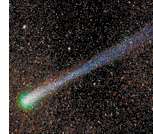
Hyakutake on March 25 1996
In March of last year (1996), Comet Hyakutake made a celestial spectacle of itself by passing within 14 million kilometers of Earth, producing a stunning sky show for amateur and professional astronomers alike.
 Look mom! No telescope! To amateurs, the comet was the brightest since at least 1976, when Comet West blazed through the heavens.
Look mom! No telescope! To amateurs, the comet was the brightest since at least 1976, when Comet West blazed through the heavens.
For pros, Hyakutake was a chance to do big-time science on these elusive, ephemeral (defined) celestial objects that fascinated the ancients. When the mid-sized comet passed close to a slew of new astronomy instruments, scientists made some intriguing discoveries:





